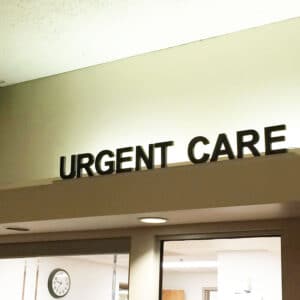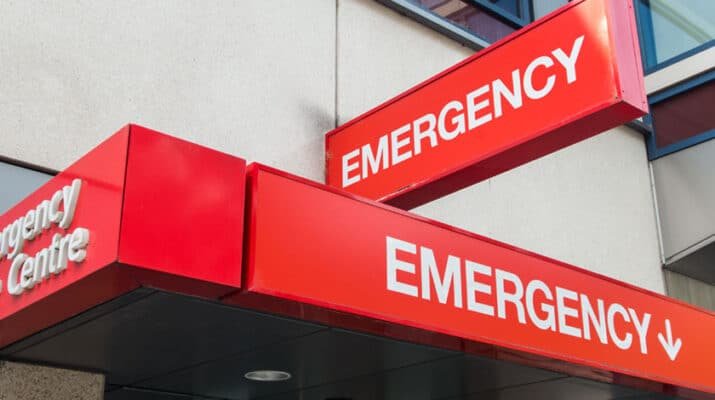Where to go when you need quick medical help
By Deborah Jeanne Sergeant
 Urgent care centers have helped decrease the load on emergency rooms. According to a 2018 study published by JAMA International Medicine, ER visits dropped by 36% between 2008 and 2015 and during the same time period, visits to urgent care facilities and telemedicine increased by 140%.
Urgent care centers have helped decrease the load on emergency rooms. According to a 2018 study published by JAMA International Medicine, ER visits dropped by 36% between 2008 and 2015 and during the same time period, visits to urgent care facilities and telemedicine increased by 140%.
Shifting to urgent care and telemedicine can help reserve ER personnel and resources for the direst cases. Knowing the difference between what is treatable at the primary care physician (PCP), urgent care or ER can continue to improve those numbers.
“More and more people are realizing that urgent care centers fill an important care gap between primary care providers and the emergency room,” said Jenilee Foster, physician assistant and regional lead provider at WellNow Urgent Care, which operates in several New York state regions and other states. “Many patients are comfortable calling their PCP as a first step if they feel well enough to wait for an appointment. However, if someone is experiencing a non-life-threatening illness or injury and doesn’t have a PCP, or their PCP is not available and they need to be seen right away, urgent care is a good option.”
Urgent care facilities typically use the same equipment as PCPs, plus have access to X-ray and other tools related to acute issues. But for issues like chest pain, suspected stroke or heart attack or a complicated fracture or burn, the ER is the right place to go.
When it gets tough is when a patient cannot wait for a PCP visit but cannot decide if their issue is serious enough to go to the ER. If the illness or injury is not life, limb or function threatening enough for the emergency room, yet the availability of the primary care physician cannot accommodate them, the urgent care is a good option to avoid waiting several days.
“Then a visit to urgent care would make sense,” Foster said.
Urgent care is not meant to replace regular care from a PCP for chronic conditions. Ongoing treatment by a primary care physician would suit these patients better as they would see the same provider instead of whoever happens to be at the urgent care.
Physician Gregory C. DiFrancesco with UBMD Emergency Medicine and director of business development, community division, has worked as an emergency room doctor and has owned urgent care centers in the past.
“What I always come back to is the layman ‘self-triage’ probably won’t be as good as your doctor triaging you to the appropriate level of care,” DiFrancesco said. “For a layperson to make that judgment is very difficult.”
That is especially true with symptoms that could indicate any number of health problems ranging in seriousness. Is the chest pain merely heartburn, treatable with an over-the-counter antacid, or a heart attack that can kill within minutes?
That is why DiFrancesco recommends starting with a call to the PCP.
“Give them the story and the symptomology,” he said. “If you can’t get ahold of them and feel you have a true medical emergency, you can go to the ER. Anyone who presents will be seen.”
He added that many times, people go to urgent care with what they think is a minor issue like heartburn and learn it’s a heart attack.
“Precious time could be lost while waiting to be seen at a level of care that can’t see that problem,” DiFrancesco said.
A PCP has familiarity with patients’ family and personal health history, which DiFrancesco said can help guide the decision.
Especially for people who have other health concerns or who are infants or elderly, it is wiser to seek help at the ER instead of waiting because they may be more prone to negative health outcomes.
Physician Kathleen Grisanti is president and medical director of Pediatric and Adolescent Urgent Care of WNY in Williamsville and Orchard Park, and president and medical director of Pediatric Urgent Care in Fairport. She said that the care offered by different urgent care practices varies.
“We work very closely with pediatricians and we recommend that people contact their doctors to help them determine where to receive care,” Grisanti said. “Many physicians don’t do stitches in their offices anymore. If they need stitches or X-rays, that would require urgent care. If a broken bone is displaced, they’d need the ER.”
“What it comes down to is every center is different. The consumer needs to know, so contact your doctor. They know what the urgent care centers in the area provide.”
Any condition perceived as life threatening should be evaluated at the emergency department, including profuse bleeding, chest pain or concern for heart attack, difficulty breathing, seizures, suspected stroke, severe burns, abdominal pain, blood clot/deep vein thrombosis, anaphylaxis, drug overdose, significant head trauma, pregnancy complications, knife or gunshot wounds, large bone fractures.

